Today’s Galarian variant Pokémon, Yamask and Corsola, are both Ghost-types, and they have some pretty different ideas about what that means. One is an ancient curse, supposedly the twisted remnants of a long-dead human corrupted by mysterious dark magic; the other is older still, the revenant of a prehistoric extinction event whose lasting effects on the Galar region we can only begin to trace. This piece might feel a little different from the others in this series, because it’s difficult to talk about Pokémon “adapting to the environment” of a new region when those Pokémon are dead and the environment is literally magic. But Ghost Pokémon consistently have really interesting lore, and there’s some cool stuff to dig into as we investigate the inspirations of these Pokémon. Let’s take a look.
Yamask and Runerigus

Unovan Yamask are tragic Pokémon, with some of the saddest backstories in the Pokédex. Yamask are supposedly the spirits of dead humans, and each one carries a clay mask which is said to represent its human face. They retain memories from their human lives and weep for their loss, their masks a constant reminder of their eternal sorrow. Which is, as the expression goes, a bummer. Once it evolves, Cofagrigus has a pretty different attitude, becoming a spiteful tomb guardian who devours grave robbers with a crazed grin on its face. Although its mask is still there, set into Cofagrigus’ forehead, according to its new Pokédex entry in Sword Version, “people say it no longer remembers that it was once human” – as if its curse has overtaken it completely. Now, Galarian Yamask… don’t have masks. Instead, a Galarian Yamask’s tail is embedded in a chunk of what looks like carved stone but might in fact be clay, since its Pokédex entry makes reference to “a clay slab with cursed engravings [that] took possession of a Yamask” (this mention of clay is the only reason I can find for Galarian Yamask to be Ground/Ghost rather than Rock/Ghost, since from every other angle these Pokémon appear to be rocky). In the case of the evolved form, Runerigus, we get a troubling line about “absorbing the spirit of a Yamask” to animate the painting on the surface of its body. Just like Unovan Yamask eventually succumb to the curse that strips away the last of their remembered humanity and transforms them into Cofagrigus, something has taken over this Yamask spirit and is gradually turning it into a malevolent force… but what?
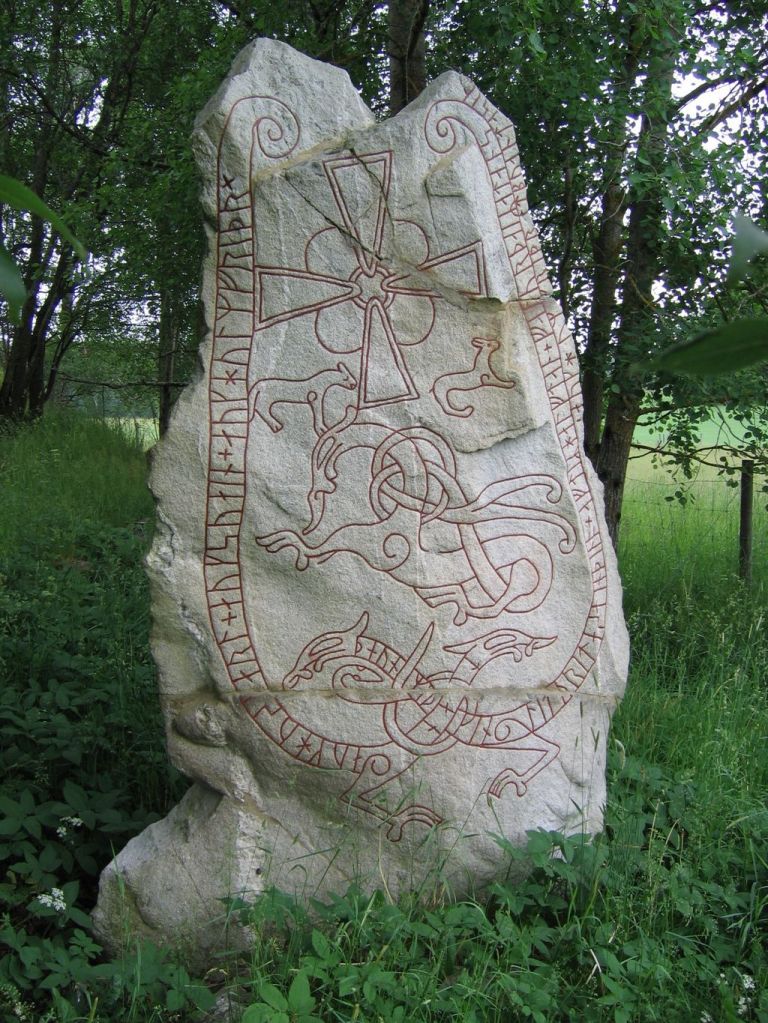
Aesthetically, at any rate, you can tell at a glance that Galarian Yamask and Runerigus are indebted to Viking runestones. Runestones are standing stones carved with pictures and inscriptions in the ancient Scandinavian runic alphabet, often following the shape of a serpent, just like we see on Runerigus. Runestones are typically memorials for the dead – usually, though not always, acting as gravestones or cenotaphs – so as an inspiration for a Ghost Pokémon that’s supposed to represent the spirit of a dead human, they’re well chosen (there are some that commemorate other significant events like agreements or payment of debts). Although most would have been brightly painted when they were first erected, normally only microscopic traces of paint survive, and modern restoration typically uses just a little red earth pigment to trace the outlines of the runes. Although it’s not really accurate to how they would have looked when they were new, that’s the image that would have been in the minds of Game Freak designers when they put together Runerigus: grey-white stone, red line drawings (I think it would be really cool to imagine an “original colour” form of Runerigus, like Magearna’s). The vast majority of known runestones are in Sweden, with a few hundred more in Denmark and Norway. However, they exist in small numbers in other regions settled by Vikings, including the British Isles (Pokémon also expresses Viking influence on Britain through the design of Galarian Meowth and its vicious evolved form, Perrserker).
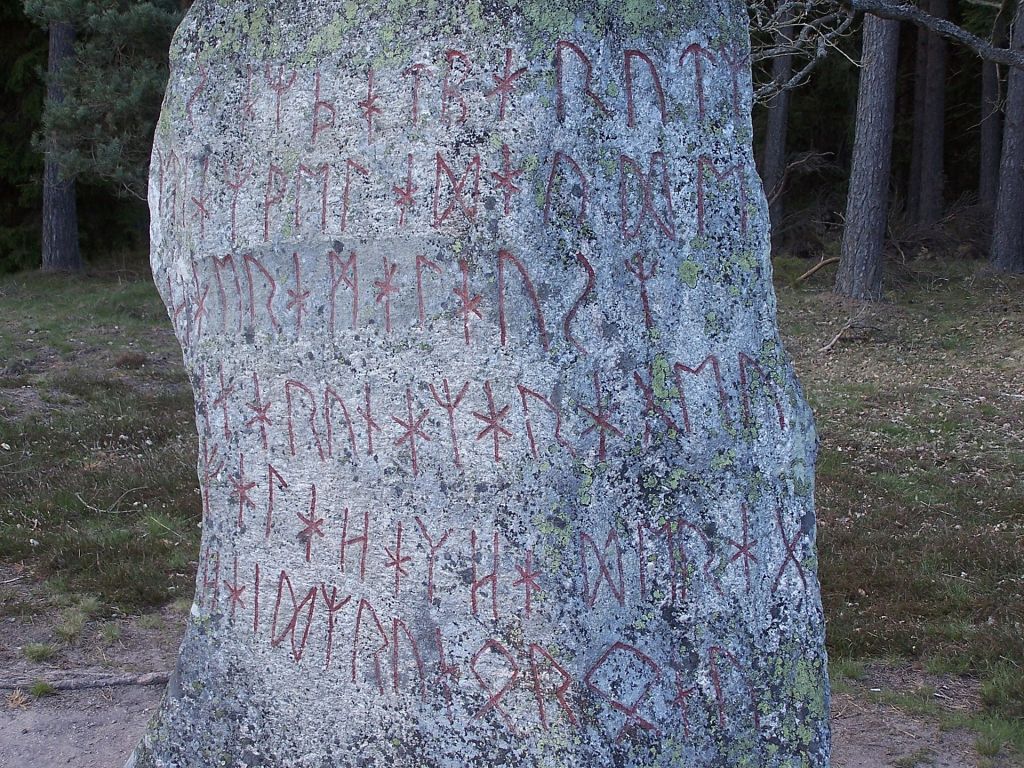
More importantly than all of that, runestones do sometimes carry curses – real ones, not bull$#!t ones like the “curse of the pharaohs” that inspired Cofagrigus (Egyptian tombs occasionally contain curse inscriptions, but not nearly as often as pop culture implies; the most famous “cursed tomb,” that of the boy-king Tutankhamun, had no magical defences against tomb robbers whatsoever). There are several runestone inscriptions promising things like “perpetual misery,” or “doom and perdition” for anyone who breaks or otherwise desecrates the stone. Yamask’s tail is embedded in a broken fragment of a cursed runestone, and as the curse takes it over more completely, so too do the cursed stones encase its entire body. Cofagrigus, we’re told, “swallow those who get close to them and turn them into mummies,” but Mummy is also the name of Unovan Yamask and Cofagrigus’ ability – by “turn them into mummies,” could the Pokédex actually mean “turn them into new Yamask”? I’d suggest that Cofagrigus isn’t so much a life form as a self-perpetuating curse; it turns people’s spirits into Yamask, which eventually evolve into Cofagrigus when the curse consumes them completely, then go on to curse others (compare the spooky implied life cycle of Phantump and Trevenant). Runerigus might be the same basic idea, but deriving from a different original curse, or perhaps even from a modified version of the Cofagrigus curse, corrupted by some kind of “parasitic” magic in Galar. Its ability, Wandering Spirit, doesn’t overwrite the abilities of other Pokémon the way Mummy does; instead, it makes Runerigus swap abilities with its opponents – like the curse is jumping from one Pokémon to another, carried by these runestone fragments.
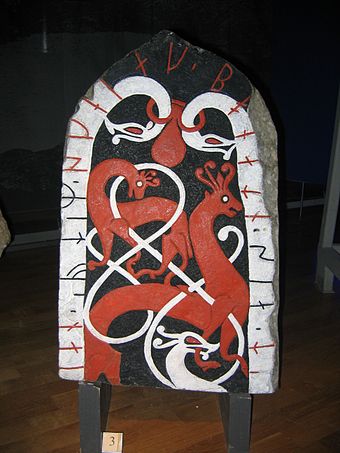
The Shield Version Pokédex warns ominously “never touch [Runerigus’] shadowlike body, or you’ll be shown the horrific memories behind the picture carved into it.” That could just mean memories of horror or tragedy from the life of the human person that Yamask used to be – this is a straightforward interpretation that makes a lot of sense. On the other hand… well, I quite like Lockstin’s implication in his analysis video on Runerigus (I don’t think he actually says this, but it’s obviously what he’s hinting at) that he thinks the serpent is supposed to be an ancient Galarian depiction of Eternatus (I take some issue with the links he draws to Jormungandr, but I’m willing to embrace it if it means we can finally bury the idea that the Kalos legendary trio is based on Norse mythology). I don’t know for sure that this is something intentionally set up by Game Freak, but it’s a cool enough idea that it should have been. In that case, the “horrific memories” visited upon any person foolhardy enough to touch Runerigus’ body could be visions of the Darkest Day, the mysterious cataclysm supposedly caused in Galar by Eternatus 1000 years ago. It would make sense if those events also had something to do with the origins of the curse and the creation of the first Runerigus. Galar is a region that cares a lot about special locations, since its regional gimmick, Dynamaxing, is tied to specific places with mystical power that have connections to the region’s ancient history and the mythology of the Darkest Day. Runestones, too, can mark special places, and if Runerigus’ stones were originally records of Galar’s history, they might have been set up over Power Spots or other magical locations – places where dark power could gradually leak into them.
A Galarian Cofagrigus – another coffin Pokémon, with a grey limestone body and carved runic decorations, maybe referencing the decorations of the Govan sarcophagus or something – would have been a perfectly cromulent interpretation of the basic prompt “Yamask and Cofagrigus, but make them Galar.” Runerigus takes the concept sideways a bit more, using monuments to the dead as inspiration instead of coffins and tying into the significance of mystical locations in Galar. You can still tell that it’s kind of the same Pokémon, because its “real” body is still those long, grasping, ribbon-like black arms and shadow-stuff holding the broken runestone pieces together, but the cursed artefacts built around the two Pokémon are totally different and take the same themes in different directions. When something should be a regional variant form and when it should be a new species of Pokémon is, I think, something of a fine line and sort of a point of semantics, and Galarian Yamask could easily have evolved into a Galarian Cofagrigus. However, Runerigus in my opinion is a good example of a concept that deserves to be a Pokémon of its own and a “split” evolution of sorts from Yamask.
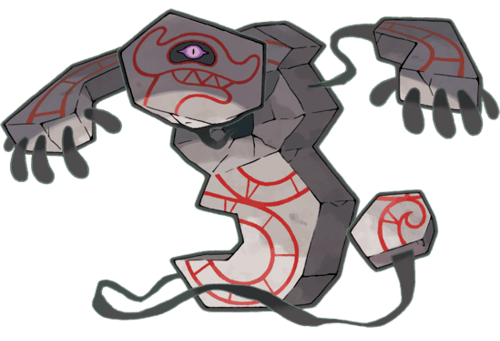
In theory, you’d expect Runerigus to work a lot like Cofagrigus in battle. It uses physical attacks in preference to special attacks, and Ghost/Ground gives it more resistances and immunities in exchange for a couple of common weaknesses, but the shape of its stat profile is basically the same (slow and tanky). Wandering Spirit is arguably stronger than Mummy because you can potentially steal a good ability, but it’s basically similar. Neither is especially consequential, since all ability changes are wiped when a Pokémon switches out. Despite all those similarities, like a lot of regional variant Pokémon, Runerigus has a movepool that’s just flat-out better than its counterpart’s. The moves it drops from its level-up list are available to it as TMs anyway, and in exchange it picks up a full range of Ground- and Rock-type attacks. Cofagrigus’ special attack movepool is decent at best, but Earthquake, Stone Edge, Shadow Claw and Body Press (a Fighting move that bases damage off the user’s physical defence stat, which in Runerigus’ case is enormous) make Runerigus a force to be reckoned with. Shadow Claw is a bit rubbish, of course, but the Isle of Armour expansion offers a move tutor for a powerful new physical Ghost attack – Poltergeist – which only works on a target holding an item, making it mostly useless in the single player story but excellent in competitive or Battle Tower-style fights. Runerigus’ support movepool is basically the same as Cofagrigus’, but with one important addition: the all-important Stealth Rock. Also, Runerigus can’t use special attacks for $#!t, but I think it’s cool as a flavour thing that it can learn Dragon Pulse (which Cofagrigus couldn’t) because of its serpent/dragon carving. Runerigus’ main weakness is that it can’t buff itself like Cofagrigus can. It does still learn Calm Mind and Nasty Plot, but with its trash special attack stat, those moves aren’t really useful to it, and it doesn’t get the physical equivalents, Bulk Up and Swords Dance.
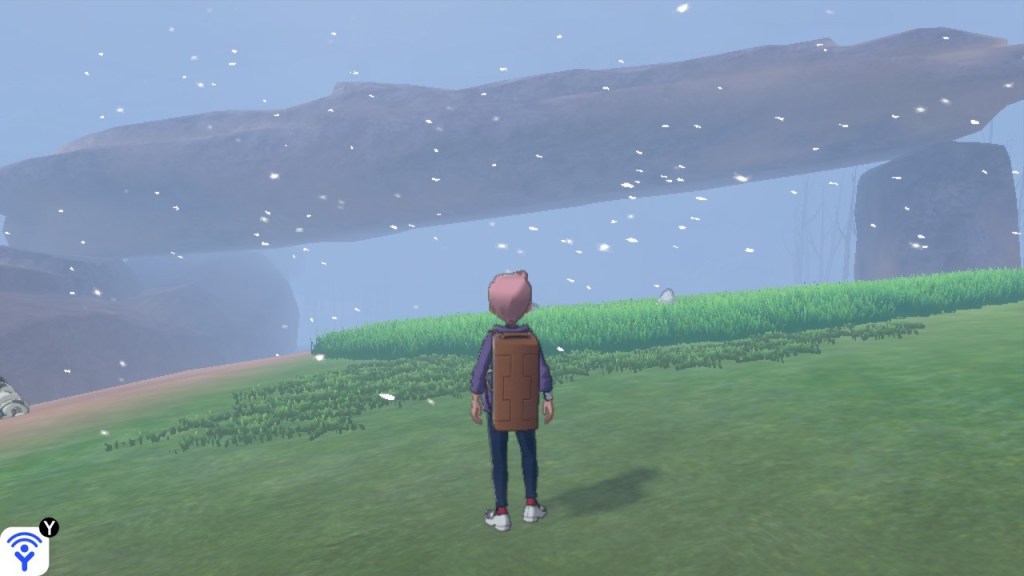
Let’s wrap up this Pokémon with a detail of the game mechanics that I don’t normally talk about: evolution. Galarian Yamask is famous for having one of the fiddliest evolution methods in all of Pokémon history: it has to take at least 49 damage without fainting, then go through a specific stone archway in the “Dusty Bowl” zone of the Wild Area (a place where Galarian Yamask do not naturally live). There are, to my knowledge, no hints within the game that you need to do this. It’s the sort of pre-internet JRPG design that seems intended mostly to sell strategy guides, or provide something to find on the fifth or sixth playthrough for people who intend to sink 500+ hours into a single game. I think you could make a really interesting game where all Pokémon evolve using obscure bull$#!t like this, and the evolutions are a puzzle to solve, with cryptic clues scattered around the game world… but when it’s just one or two in a generation, it’s more annoying than anything else. What’s especially galling is that this evolution method, in isolation, is pretty cool! Again, Galar is a region that emphasises the power of the land itself and the importance of specific mystical locations in the landscape, while Runerigus is a Pokémon based on monuments that mark special locations. Getting Yamask injured in just the right way before you take it to this magical place feels like performing steps in a rite, or making a sacrifice. There’s arguably even an interesting significance to the 49 damage you have to take. As Bulbapedia notes, 49 days is, according to some sources and traditions in Buddhism, the duration of the “limbo” state of bardo that the soul exists in after death and before reincarnation. Yamask is a wandering soul that needs to be “reborn” with a new purpose, and this is exactly the same kind of weird numerological reference that we’ve seen before in Spiritomb’s evocations of the number 108. There’s a lot about this process that’s really cool, but it just doesn’t feel like it belongs in this game or reaches its potential for creating a powerful moment.
Anyway, that’s more than enough on Yamask and Runerigus – let’s talk about Corsola.
Corsola and Cursola
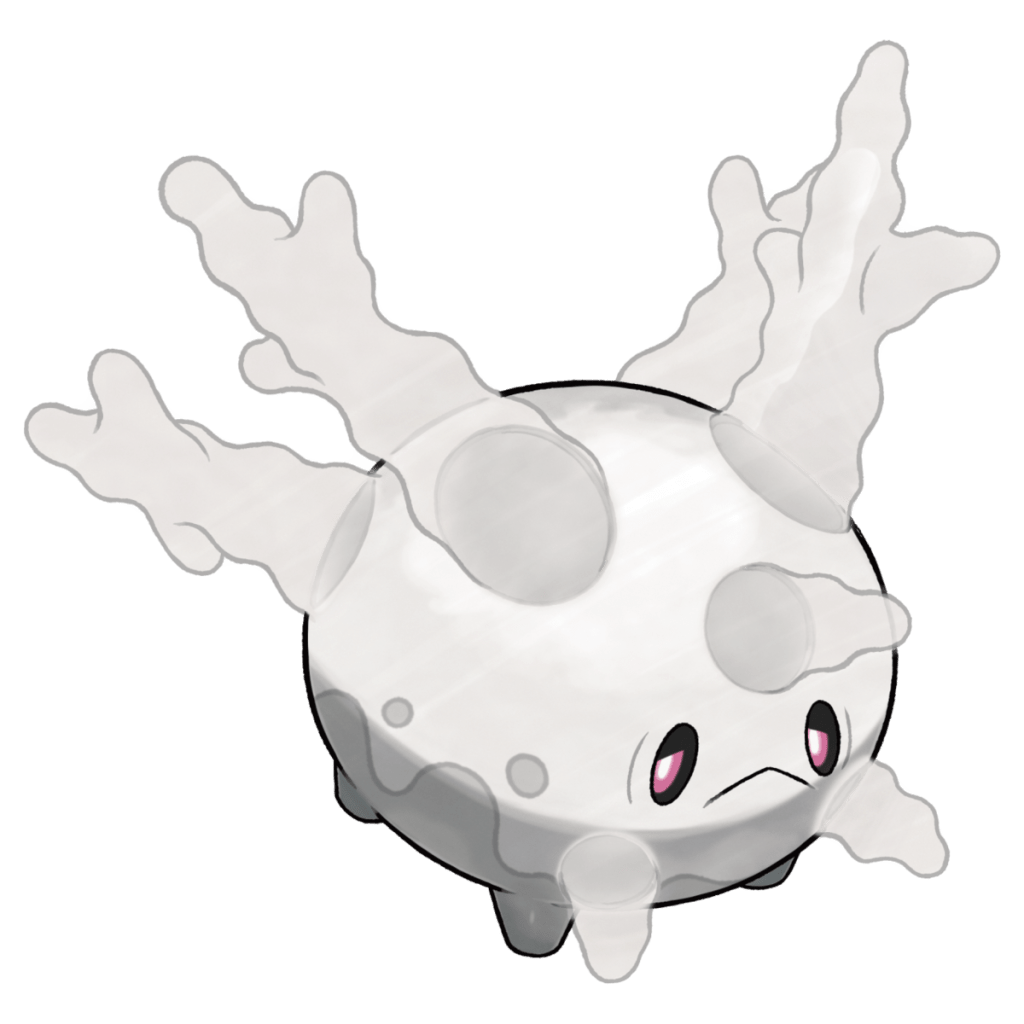
Corsola are long extinct in the Galar region. According to the Pokédex, standard Johtoan Corsola (…Johtoan? Hoennese? Alolan? I’m just going to say Johtoan because that’s where we first met them) lived in Galar’s oceans “in prehistoric times.” However, they died long ago due to “sudden climate change.” However, unlike other extinct Pokémon that left behind fossils, Galarian Corsola (like another Galarian Ghost-type, Dreepy) continue to linger in the region as spirits, eons later. These undead Corsola exchange their miraculous powers of regeneration for the ability to drain life force from other beings, their vibrant pink colour becomes a stony pale grey, and their precious horns – beloved by jewellers and artisans all over the Pokémon world – are replaced by wispy protrusions of ectoplasm. They can also evolve, which normal Corsola cannot, into Cursola, the coral of their bodies breaking open completely so that their ghostly forms spill out, no longer contained to a physical form. The Sword and Shield website attributes this to Cursola’s energy becoming too powerful to contain because it has drained so much life force from so many other beings. The website also says that Cursola has a mysterious relationship with the moon – they “gather on the night of the full moon and fire off their branches toward the sky,” possibly to release some of that excess energy, possibly to communicate with other Cursola. I was totally prepared for this to be a generic spooky Ghost-type thing and maybe a tie-in with their grey-white colour scheme, but apparently there is real research from the last couple of decades showing that corals actually rely on moonlight and the cycle of the full moon to regulate their reproduction. Neither Johtoan nor Galarian Corsola can learn Moonlight or Moonblast, so they probably aren’t drawing power from the moon in the abstract way that other Pokémon do. It could be that those observations of Cursola appearing to beam energy to the moon are, like real coral under the full moon, engaged in part of a mysterious and esoteric reproductive process – in which case we could reasonably ask, are they really the ghosts of an extinct species at all, or are they just an extremely weird adaptation produced by extreme environmental changes? But before I go too far off the deep end, let’s look at what inspired this design.
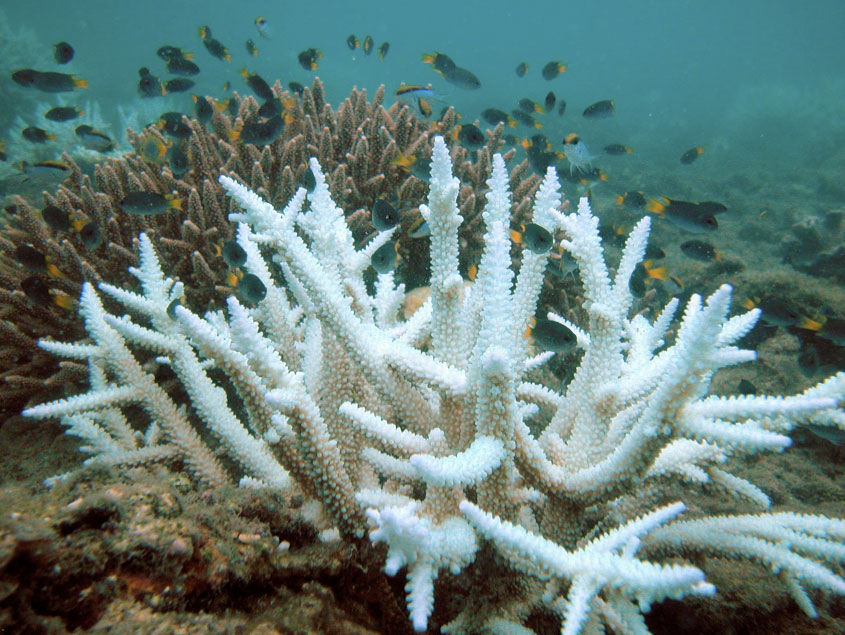
The pale colour scheme and Ghost type of Galarian Corsola are a pretty straightforward reference to the eerie, haunting look of bleached coral reefs – a more and more common sight in tropical seas around the world, as rising global temperatures and ocean acidification slowly destroy ancient reefs. Corals are communal organisms made up of millions of tiny soft-bodied invertebrates called polyps, which build calcite “skeletons” in a wide range of distinctive shapes, and share those skeletons with colourful symbiotic algae called zooxanthellae that use photosynthesis to provide the coral with energy. A coral reef is a huge community of many coral colonies from multiple species, inhabited by an incredible range of other marine animals – some that feed on the coral itself or its algae, others that feed on those species, still others that rely on the coral for shelter from predators or turbulent currents. Corals form the foundation of some the most diverse and beautiful ecosystems on the planet – but they’re also extremely fragile. Small changes in the depth, temperature or acidity of seawater (all things that humans have been causing by pumping large amounts of carbon dioxide into the atmosphere for the last 200 years) will make coral expel its brightly-coloured zooxanthellae, leaving it bleached white. The coral isn’t technically dead at this point, and can recover if the water conditions return to the ranges it’s comfortable with – and we can ask here whether Galarian Corsola is “really” “dead”; its ectoplasm traces the places where its horns “should” be, and Cursola’s ghostly form mimics the tree-like structure of staghorn coral. It seems like something in them still knows what shape they’re supposed to be, but their physical bodies can’t hold that shape up anymore. That’s what happens next: if bleached coral doesn’t get its photosynthetic algae back quickly enough, the polyps will starve and the coral will truly die. The reef will crumble over time, just like a Galarian Corsola’s physical body crumbling as it evolves into Cursola, and the vibrant ecosystem it supported will collapse, leaving only a few sad, broken shards of coral… and the ghosts of the past.

Exactly why the old Johtoan Corsola died out in Galar is left vague. If they went extinct in “prehistoric times,” it can’t have been the result of any human activity parallel to the real industrial revolution, and of course there have been real prehistoric coral die-offs caused by natural climate shifts and sea level changes as well. One Pokédex entry refers to “areas oceans once covered,” implying that Corsola went extinct in Galar because the oceans they lived in dried up, and they now “haunt” the same places, like fossils of shellfish found in inland regions that were once underwater. I could see this as a fun little nod to Britain’s role in the early history of palaeontology, particularly in the early 19th century. But in the actual game, wild Galarian Corsola are primarily found in a place that does still have water: the Giant’s Mirror lake in the Wild Area. The Wild Area is all lowland, with several large lakes, and I can believe that the whole of central Galar might have once been an inland sea (this works for Dreepy as well, and for two of the four Galarian fossils – Arcto-dino and Fish-vish both seem aquatic). On the other hand, the Pokédex refers to the seas surrounding Galar, which are very much still there, and the Sword and Shield website makes reference to a meteorite impact. Any mention of meteorites is always a big red flag in Galar, because Eternatus – the mysterious Pokémon that caused the Darkest Day – is supposed to have come to Earth inside a meteor 20,000 years ago. The Darkest Day recorded in Galar’s history is much more recent than that, but there could easily have been another similar cataclysm after Eternatus first arrived – one that wasn’t ended by a pair of heroes, and lasted much longer.
That more or less brings us to the main issue I have with designs like Galarian Corsola (and, for instance, Yungoos in Alola): it references real world ecological issues, but Pokémon doesn’t usually have a consistent idea of how its own regions’ ecology works. Corsola’s a cute and fun Pokémon with some interesting powers, and the Galarian twist on the design is certainly interesting, but I don’t think we’ve seen Pokémon do anything with either form that fully expresses just how important corals are, or how devastating their loss can be to marine ecosystems. I love that this design is here and serves as a way of introducing people to some major ongoing consequences of global warming, but I think Pokémon may just be too happy and upbeat to take the risks that would really let it stick the landing (something I’ve talked about before at… some length). In the Pokémon world, when corals go extinct, other species can learn to make do without them, and the corals themselves may later come back in a new spiritual form. That’s not entirely unrealistic either: life finds a way; many species do adapt in surprising and fascinating ways to extreme stress, and corals have survived ecological disasters before the ones we’ve caused. But right now, looking at this design, and what it seems to be based on, I don’t think Corsola and Cursola really understand the gravity of what they are.
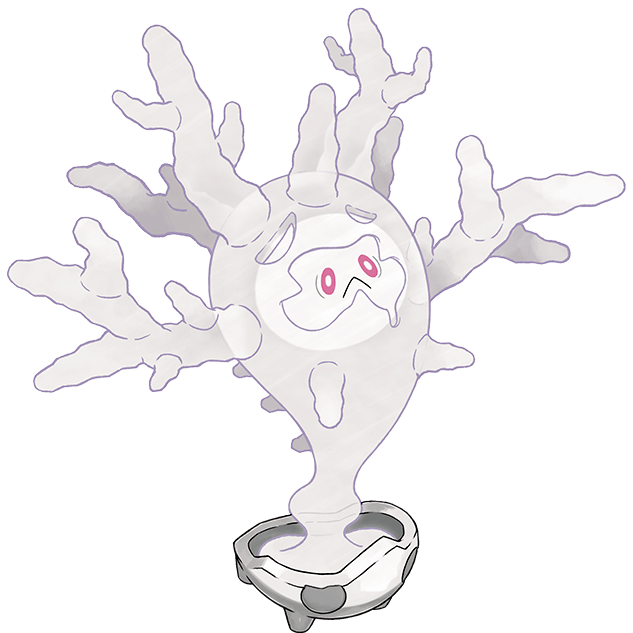
Galarian Corsola is a completely different type from the Corsola we know – not Water/Ghost or Rock/Ghost, just Ghost. It actually has much better physical defence than Cursola, and it’s possible that Galarian Corsola was always intended to be able to function unevolved as an Eviolite tank (which Johtoan Corsola can’t try, because it has no evolved form). It doesn’t have a living Corsola’s most powerful tanking asset – Recover – but it does get an alternative healing method, Strength Sap (described in more detail in my review of Shiinotic), its buffed defences are substantial, and Ghost-types have few weaknesses. Corsola’s attack scores are rubbish despite its solid special movepool, and with an Eviolite in hand it can’t use another item to increase its power, so it would be kind of a sitting duck. Fortunately, Galarian Corsola is a Ghost-type and can learn Night Shade, which does damage based solely on the user’s level. It can also burn opponents with Will’o’Wisp, making it especially good at shutting down physical attackers. Aside from that, the main standouts in Corsola’s support movepool (whether Johtoan or Galarian) are Reflect, Light Screen and, most importantly, Stealth Rock. Galarian Corsola’s hidden ability is Cursed Body, which confers a chance to disable attacks that make direct contact with Corsola. The randomness makes this a pretty shaky ability, but Eviolite Corsola is arguably the toughest Pokémon that can use it, and in conjunction with the healing from Strength Sap, it could potentially put an attacker in a very awkward spot.
The evolved form, Cursola, is only good at defending against special attacks, presumably because so much of its essence has leaked out of its protective coral shell. Its physical defence is extremely weak, and like its predecessor it’s extremely slow, so it has to be handled with a lot of care – switching in only against Pokémon known to favour special attacks, and switching out at the first sign of trouble. It has a passable physical attack stat, with which it can use some moves that aren’t on a standard Corsola’s list like Revenge and Leech Life, but its special attack is where it’s at: this stat is through the roof, matching Chandelure and Vikavolt and only a few points short of Reshiram. Cursola has original-recipe Corsola’s full special movepool – Surf/Hydro Pump, Power Gem, Ice Beam, Earth Power and Psychic – and its own Ghost attacks like Shadow Ball, plus Giga Drain thrown in as a bonus. Corsola – whichever form you use – simply doesn’t have the power to make good use of that selection. Cursola absolutely does, and its treacle-like speed makes it a strong candidate for a Trick Room team. With access to Calm Mind and Strength Sap, as well as an excellent special defence stat, it can also reasonably try to be more of a blasty tank, although its pathetic physical defence is a substantial weak point. Poor physical defence also makes both of its ability choices pretty impractical. Weak Armour improves your speed at the cost of physical defence whenever you take physical damage; Cursola, unfortunately, probably needs more than one speed boost to attempt anything resembling a sweep, and can’t reliably survive two physical attacks from almost anything. Cursola’s hidden ability upgrades from Cursed Body to the unique Perish Body: when Cursola is hit by a move that makes direct contact, it will automatically invoke a Perish Song effect, causing both Cursola and its attacker to faint three turns later. This is really interesting and flavourful in theory, but awkward in practice. A Pokémon’s Perish countdown is wiped if it switches out, and Cursola’s only way of stopping opponents from doing that is Whirlpool, which is a little hit-and-miss. Moreover, this is another ability that forces Cursola to take physical damage. You can look at Perish Body as a way of forcing an enemy to switch out, but there are simply more efficient ways of doing that.
I have my issues with these designs – sure. In the case of Galarian Yamask and Runerigus, I’m mostly just annoyed by the weird evolution method and that one strange detail of whether the runestones are rock or clay, where the Pokédex’s report and the Ground typing seem inconsistent with the runestone inspiration and the Pokémon’s general appearance. Those are nitpicks. My problems with Cursola are much more broad and philosophical, and relate to concepts that aren’t even Cursola’s fault, really – Pokémon’s relationship to the messiness and high stakes of real world ecology is something I’ve had a bee in my bonnet about for a while. But the designs themselves are really cool, and great twists on the original Yamask and Corsola that do a fantastic job of exploring the broader space of what these Pokémon can be, even though Corsola doesn’t have any obvious link to the real region Galar is based on. And… well, if you’ve been around here for a while, you know I’m a sucker for spooky lore that changes the way we look at ghosts and spirits in the Pokémon world.
Effervescent thanks for supporting this article, and everything I do here at Pokémaniacal, to my mysterious and shadowy Patrons, and in particular to the three members of my Dark Council: Miame Irohara, Intonyeon and Name (Required). If you enjoy my writing and would like me to be able to keep doing more of it, consider joining their ranks and becoming one of the chosen apostles of the void of dreams at the end of days a regular Patreon donor at https://patreon.com/pokemaniacal!

I like to think that G. Yamask are the ghosts of people killed by whatever Runerigus’s stone slab is depicting (maybe Eternatus, or a really mean snake, or maybe more metaphorically northern raiders). I like when video games offer you to puzzle together plotlines and backstory by exploration, and I feel this line really had the potential to give players a really disturbing plot to figure out, but it’s not quite there…
LikeLiked by 1 person
Mmm; there’s a *lot* of that unexplored potential in Pokémon; it’s actually something that I think the Detective Pikachu game did quite well (although not with anything as dark as in this case).
LikeLike
Speaking of unexplored potential, a game where all Pokémon evolutions are puzzles to solve sounds so good – it also synergizes well with the player piecing together plot stuff by exploration…
LikeLiked by 1 person
Note that a certain line should probably be amended to “known to favor special attacks and isn’t a Psychic-Type”, because Psyshock exists and Ghost doesn’t actually resist it. Wouldn’t that be embarrassing, losing to a type you’re supposed to be good against.
LikeLike
It’s rather nostalgic!
LikeLike
You watch Lockstin?? I figured you wouldn’t be a fan of a lot of his particular theories, as he tends to reach a lot and (if I recall correctly) did push the whole “XY Norse legendaries” theory.
LikeLike
I don’t normally, but I did see his Runerigus video while researching this article and thought it was well done. I don’t *dislike* him and I respect the amount of work that clearly goes into his videos, but yeah, I definitely have… mixed feelings about some of his work.
LikeLike
I generally don’t watch much of his “theory” videos but I do enjoy his “every __________ explained” videos. I think it’s the fast paced burst of information. Occasionally I’ll watch his theory videos, and I feel they’re hit and miss – some feel like stretches, some feel spot on, and some are a mix (like the recent one about Tyranitar and kaiju). I do like his style of videos though, even when I think he’s stretching. Seems like a chill dude.
That being said, his Runerigus video is one I skipped so I might go back and watch it.
LikeLiked by 1 person
Re: Galar’s emphasis on the energy of the land, I was surprised to learn that power spots are a thing in real life Japanese culture! They’re areas of spiritual power, like ley lines.
LikeLiked by 1 person
Very interesting insights, as always! What do you reckon these two add to our current understanding of Ghost-types? Runerigus, in particular, fascinates me because it’s a big new step towards the idea of curses in the franchise. Game Freak have gone back-and-forth with how they envision curses (see, for instance, the original ??? classification of, well, the move Curse), and Runerigus is neat because it makes me feel like there are almost… regional variations of curses? That can somehow affect certain Pokémon? It’s a cultural aspect that I wasn’t expecting they would incorporate, but here we are. Like, we’ve seen curse-centric Ghost-types before – Mismagius and Banette come to mind – but they operate on an individual level, whereas Yamask in either form seem to represent differing cultures. Makes me wonder if GF didn’t miss out on an opportunity to make a Ghost-type Pokémon based on Native American burial ground curses instead for Unova.
I didn’t think about the Gumshoos line of argument for Cursola, but you’re absolutely right. Perhaps a charitable interpretation of GF is that they’re trying to draw out sympathy from the audience towards the whole coral bleaching issue? J-Corsola are usually considered very cute but G-Corsola and Cursola are memetically-sad; I wouldn’t be surprised if that’s the contrast GF were going for, in a manner not dissimilar to how the WWF uses the giant panda as their poster child.
Speaking of which, this is the second region in a row where GF used Corsola to examine environmental issues: predation and overhunting in Alola, and coral bleaching in Galar. I get that coral reefs are easy, iconic things to serve as a metonym for larger biosphere as a whole, but I do wonder why GF seems to focus on corals more than, say, the rapidly-dwindling bee populations. Is it because Japan itself is an oceanic nation? Hmm…
LikeLiked by 1 person
Yeah I doubt GF would’ve EVER made a Pokemon related to Native American burial grounds. That sounds like a very dangerous can of worms for them, especially if they’re afraid to properly address what happened to the Alolan royal family and connect that to the Hawaiian royal family.
LikeLike
I think it makes a lot of sense that curses, magic and the supernatural might work differently from region to region, and for that matter from species to species; that’s kind of how it works in the real world. This is one of those places where I kinda doubt there is an underlying consistent system of metaphysics in the heads of anyone at Game Freak. Speculating and constructing our own worldbuilding concepts might yield more of interest than trying to figure out what the “real” rules are… maybe there’s an article or three in that?
On Cursola and environmental messaging – I do think that’s exactly what they’re trying to do, and honestly I like that they’re *trying*. It’s just difficult for something as upbeat as Pokémon to really talk about heavy consequences, or the world ending in a way that one hero can’t fix. Like I said, this isn’t even Cursola’s “fault,” really; it’s more a philosophical difference I have with the creators.
LikeLike